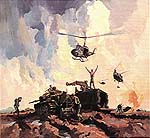
A Tale of Two Meteors: The Repetitive Lifecycle of a Tank Engine
Wear and Tear: The Life of a Meteor
Moving 50-odd tonnes of metal across wildly varying terrain and under extremely variable atmospheric conditions places enormous stress on automotive components, so it is perhaps not surprising that engines, just the same as all the other major unit assemblies that made up the drive train of a Centurion tank, became unserviceable due to ‘fair wear and tear’ on a monotonously regular basis.
A report compiled in January 1970 stated that the average distance traveled by an Australian Centurion AFV before its Meteor engine required overhaul was 1104 kilometres in 1961, and 850 kilometres in 1968. Another report based on Meteor engine overhauls between October 1966 and June 1970 found that the average distance was around 1120 kilometres between overhauls, with the most common reason for removal being a loss of power and excessive oil consumption. Loss of coolant and overheating was the second most common cause of failure. Comparatively few engines suffered catastrophic failure such as broken connecting rods.
Overhauls in Australia were carried out by Hawker De Havilland Pty Ltd at their Lidcombe, New South Wales facility. The company had a Department of Supply contract to undertake Meteor engine overhauls and modifications. They were also contracted to provide ‘engine failure’ reports on engines that had failed well under the average distance expected. The company also overhauled engines for the New Zealand Army’s Centurions as part of the same Department of Supply contract, by an inter-governmental arrangement.
The time taken from removal from the tank to completion of rebuild was between 6 and 12 months. In the early 1960s, the cost of a rebuild was $2,514, but by 1970, this had risen to $5,100, not including the cost of parts which were supplied from Army stocks. The rate of annual engine change-over also rose, from an average of 50 in the years before 1968, jumping to 120 per year from 1968 onwards - the period of intense training and the deployment of the tank squadron on operations in South Vietnam. Coupled with this was a growing shortage of critical components, which resulted in a slow-down in the completion rate of engine rebuilds.
To help relieve this shortage, rebuilt engines were purchased from the United Kingdom. Examples included overhauled Meteors by Scottish Aviation and Rolls Royce Glasgow. Crews thought very highly of such engines, which were thought to have a better performance than those rebuilt by Hawker De Havilland.


